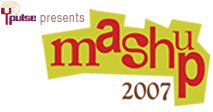
SAN FRANCISCO — A curious thing happened at the Hotel Nikko in downtown San Francisco today during the Ypulse Mashup 2007 conference about those wired teens. Yes, a lot of older folks dressed business-casual tried to look hip and decipher what the kids were doing online in social networks, on mobile phones and in virtual worlds. But on numerous occasions, the bigwigs from startups and even established media companies mouthed and spoke the words teens have long wanted to hear come out of their so-grown-up mouths: We cannot tell teens what to do; they are the ones in charge online.
The same scene seemed to play in “repeat” mode all day, as one exec after another begged off knowing just what the teens want, grumbling that they were known as the “teen” around the office but, ahem, they are years removed from actual teendom. So instead of pretending to know what’s hip and cool and how to run their online communities, they actually defer to the teens themselves — on their staff, in the communities — to decide how to run the sites and what content will work there.

During a rare run of company presentations late in the morning (most panels had very little in the way of PowerPoints), the president of eCrush made this candid admission: “I wish I was 17 but I’m not. They are! I’m not steering the bus, they are!” The strategy has worked well for the site, which helps teens find out if their secret crushes also have crushes on them. The site, along with a sister site with the improbable title of eSpinTheBottle, were recently sold to Hearst New Media, showing that even the bigger fish online are learning to play nice with communities and give participants more control and input.
One of the biggest shockers of the day was on the panel titled “Old School to New School” filled with folks from traditional media companies trying to teach their colleagues new media tricks. Dixie Feldman, editorial director for MTV’s teen-focused cable channel The N, said she wanted people to come to them for content, and also to remix and share their content elsewhere — a free-flowing idea that flies in the face of parent company Viacom’s $1 billion lawsuit against YouTube.
“We’re definitely not threatened with people using our content,” Feldman said. “We take provocative scenes of shows they love, and let them make new mashups. We let them post them on MySpace, YouTube, and we provide shows for free download on iTunes.”
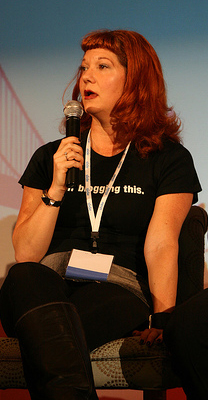
Feldman explained that they even let fans put in their own audio comment track for remixed video, what they call “vommenting,” and then let them post it online at other sites. I asked if this represented a change for Viacom, allowing people to post clips on YouTube. Feldman backed down a bit, saying these were her own views on the matter, and that she couldn’t speak for the parent company.
“If you want my opinion, I think our content should be everywhere,” she said. “I want it on YouTube. But that’s a complicated question. I can’t answer whether content should be there or not, and I can’t really speak for the company.”
While Viacom has been strict about having YouTube take down video content from shows like “The Daily Show” and “The Colbert Report,” I found about 8,000+ search results for Degrassi= on YouTube recently, including many clips from The N’s TV show of the same name. Of course these shows pale in comparison to the popularity of shows on MTV or Comedy Central, but it’s still a big departure from the hard line Viacom has set around sharing content at YouTube.
But back to my original point: The companies that are succeeding with online communities for teens are giving control over to their users to some extent. And in the case of Linden Lab’s Teen Second Life virtual world, they even give teens (as well as adults) the intellectual property rights of what they build in the worlds. Claudia L’Amoreaux, community developer at Second Life, noted that they did absolutely no marketing or outreach to teens beyond having a group of them do beta testing and tell friends.
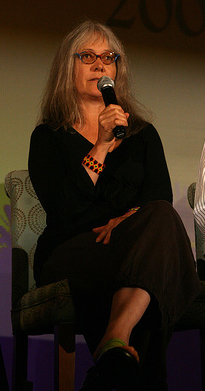
“We don’t bring teens onto our site; they bring themselves,” she said on a panel called “The New School.” “It started with a small group of teens…and it’s slowly grown. It’s amazing to see what they are doing. The teens are quite entrepreneurial. They own islands, and are developing their own housing and malls and clothing. They are the most advanced scripters in Second Life. A young teenage woman from the UK created a way to enter into Second Life through the web, which blew us all away. She was the first to do it….[Plus adults are now] teaming up with teens to co-develop parts of the islands.”
Teen Marketing That Works
Along with the theme of giving up more control to teens in social networks and online communities, the other repeated refrain was doing marketing in these realms that were relevant and fit in with the sites’ experience and feel. And in some cases, the marketing message would morph into customized “widgets,” mini-applications that people could load onto their social networking profile pages, blogs or computer desktops.
Melanie Strong, Nike’s brand manager for the build-a-shoe site Nike iD, talked about how the big shoe maker wanted to change their marketing ways from a TV focus to one of on-demand, giving consumers more control of their experience.
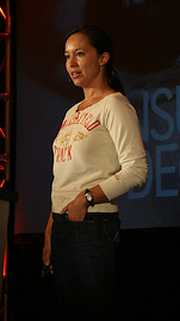
“We have a long way to go online,” Strong said. “We have to think about how we can create experiences online around customization, and really put consumers in charge.”
Rather than try to build their own social network, she said Nike would simply build tools, like a “build your own shoe” widget that users could post on any other site.
Craig Sherman, CEO of teen virtual world Gaia Online. said they were very careful about inviting the right companies into the community to interact with residents — and that strategy paid off when they did the right promotions.
“We [wanted] sponsors that made the world better,” he said. “The Nancy Drew character came on the site, asked people to go on a quest, watch the movie trailer [for the Nancy Drew movie], follow clues, pass a quiz, and then get a sleuth kit to use in the world. In the first two weeks we ran this promotion, we became the highest referral site on the Net to the Nancy Drew movie site. For Toyota’s Scion, we let people ‘buy’ virtual cars and then customize them — just like the Scion theme of self-expression. There were 27,000 cars bought in the first hour.”
Not only do companies have to market differently in teen-oriented worlds, but traditional media companies are also learning to converge online and offline marketing staffs. Diane Naughton, vice president of marketing for book publishing giant HarperCollins’ Children’s Books department, noted that change at her 190-year-old company, now owned by News Corp. and marketed on Fox Interactive Media’s MySpace juggernaut.
“The biggest change for us as an old media outfit was changing the way we market,” she said. “We used to just have an online division, but now our traditional marketers are doing both [online and offline marketing], it’s converged and it’s not just the online marketing group doing that work.”
Traffic Over Profits?
As with any technology-related conference happening in 2007 in the San Francisco Bay Area, the trade booths were filled with various Internet startups with funky names such as Gorilla Soapbox and DayZLoop. And I had serious flashbacks to the dot-com boom era when startup execs trotted out growth numbers for downloads, user numbers and visits, with only vague talk of business models related to advertising or perhaps paid content through mobile carriers.
HarperCollins’ Naughton was one who brought up the bugaboo of actually making money from all these hip, cool online ventures for teens.
“We have a lot of content, but how are we monetizing it?” she asked. “At the end of the day, our CEO says again and again, ‘How are we making money with it?’ Are we becoming an e-commerce company? How does that change our relationship with stores like Barnes & Noble? Monetization is the biggest issue for us to move forward with in a structured way.”
Even though there was a bit of built-in scorn for old media companies on their panel vs. the new media companies on the “New School” panel, it is the old-schoolers that are actually profitable while new-schoolers have a two-word business model pasted on their foreheads: “Buy me.” When I asked the “New School” panelists if any of them were profitable, Photobucket CEO Alex Welch said “in some months we make money.” And they are the star of the social networking apps realm being a photo-sharing site that was recently bought for $300 million by MySpace.
But I was surprised by the response from Linden Lab’s L’Amoreaux, who said that Second Life was now profitable, following years of losing money. Of course just how profitable it is remains to be seen. Fast-talking CEO of RockYou Lance Tokuda was a fountain of statistics, noting how popular his widgets had become on the now-open Facebook platform. He talked about scenarios of how RockYou would charge other companies to boost downloads of their own widgets. But that idea of “pay me to get your widgets where mine are” doesn’t quite have the ring of helping teens find the content they want.
The other problem during the dot-com era was all the startups using borrowed venture money to buy up ads on the other startup sites, a chain that broke down when the money stopped flowing and the advertising business busted. On many panels, the talk turned to free online applications for teens supported by advertising. On the “Totally Mobile” panel, Jed Stremel, director of mobile for Facebook, said he liked the free ad-supported model over mobile content that teens pay for through their carrier (which is billed to mom and pop).
Sam Altman, CEO of Loopt, noted that his map-based social networking app for mobile phones was successful, despite a $2.99/month price tag, meaning that paid content works with some cell content. Loopt today announced a deal with Sprint to offer a mapping service where friends can find each other on maps on some smartphones with GPS capabilities. But in response to Stremel’s point about making services free, Altman mentioned that Loopt would be announcing more business models beyond the pay one. Mixing up revenue streams is perhaps the best way to get past the inevitable boom-and-bust cycles of advertising and the drop in cost for cell data plans.
Pluses & Minuses
Overall, for a first stab at a conference, Mashup 2007 was pretty decent, and attracted a good combination of academics, marketers, researchers, journalists, startup execs and various others. There was the obvious problem of a bunch of old farts in button-down shirts (guilty as charged) trying to look like they were hip and with the teen generation. Having old folks talk about teens all day is like having retirees talk about their favorite gangsta rap artists — it just sounds wrong. And bringing in the cliched “teen panel” doesn’t quite cut it.
“Authenticity starts with us, and ‘cool’ isn’t a stag you can hunt down and drag home,” wrote Angela Natividad about Mashup 2007 on the AdRants blog today. “It’s like love (or lust?) — you feel it. You know it when you see it. And baby, look around. We are not it.”
So how to solve that problem? Perhaps there should be a teen on every panel, a kind of BS detector for when the grown-ups get out of line and start pontificating.
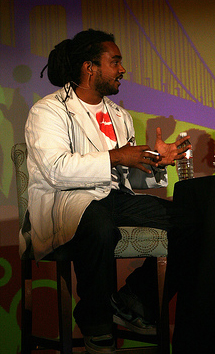
There were some other nice touches at the conference. Karl Carter of Inner City Enterprises had the audience text message him with questions for the “Social Change” panel, and there were various “user-generated” discussion roundtables during lunch. It was a rare time at a conference where I felt like I got more out of a lunch discussion on widgets than I did from many of the panels. My only nitpick was that I didn’t know to sign up for the lunches ahead of time.
And my final nit was the usual appearance of representatives from conference sponsors on panels. That practice seems to be falling out of favor at some of the “unconferences” coming into vogue, and it would have been nice to see that here as well. I’m not complaining about the quality of those panelists as much as knocking the appearance that companies could simply buy their way onto panels.
If you attended the Mashup 2007 conference, use the comments below to share your thoughts on it. What worked for you, and what didn’t? What big takeaways did you learn from it and how could it be improved? I’ll update this post with any important thoughts or responses, even if they come from other blogs.
All photos are by MediaShift associate editor Jennifer Woodard Maderazo. You can see her full stream of photos from the conference on Flickr here.
UPDATE: Anastasia Goodstein from Ypulse was the organizer of the conference. She reacted on her blog to my criticism of having sponsors on panels:
I was as transparent as possible about this in the [blog] posts leading up to the event, i.e. that we did include speaking as part of one of the sponsorship levels. For future events, we plan to only include sponsored case studies and clearly label them as such. Any speaker on a panel, who happens to also be a sponsor, will have been invited to speak first. The two tracks will be kept separate.
I think that’s a good idea, as you get an echo chamber effect having speakers who are also sponsors bombarding attendees in such an overarching way. And if you’re going to do a conference about being authentic and doing advertising online in new collaborative ways, it makes sense to extend that to the conference itself.

Thanks for your thoughtful summary, Mark. Karl Carter and his panel were a real high point of the conference for me too. Having gone to the Music session the day before, the two themes I picked up on were mobility and authenticity.
The music session was all about success built on the grassroots – sustained, direct connection with fans via social networks; the nimble new label that’s about pulling together a family of talents that supports that fan-connected artist – stuff like that. It projects as honest, homegrown, real, authentic, as opposed to the create-a-big-star-style, mostly-marketing, illusion-based business that’s been going for awhile.
danah boyd spoke to mobility (the way teens’ tech us is going, she felt) vs. immersion (e.g., Henry Jenkins’s examples of people’s total immersion in various online fandoms). I actually think that mobility or fluidity – teens using all kinds of technologies, sites, and devices for different things at different times – includes immersive experiences too. I guess there will always be the highly focused people into World of Warcraft or Harry Potter, but as immersed as they are compared to most of us, they’ll also be using different devices and technologies to communicate with non-WoW-focused friends. The only thing that won’t work for anyone going forward is non-interoperability and closed networks, I suspect. Good to meet you,
Anne
myspaceunraveled.com
netfamilynews.org
netfamilynews.blogspot.com
blogsafety.com
Teaching old people how to manipulate and make profit off of young people is really what this seminar was about. Dipping in to social networks like MySpace to help promote their own products, sculpting kid’s opinions so they will feel worthless if they don’t have the newest iPhone, fully aware that kids will get the $600 because of advertisers’ hunger for money and kids’ desire for a higher self-esteem.